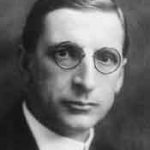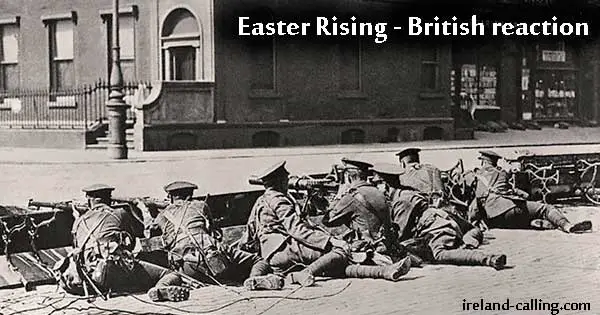The British authorities in Dublin Castle were taken completely by surprise by the Easter Rising in 1916. British spies had infiltrated many of the organisations taking part and so the authorities knew that something was being planned; they just didn’t expect it to happen as soon as it did.
They may have been comforted by the notice placed in the Independent newspaper by Eoin MacNeill saying that all military manoevres over Easter had been cancelled. The notice was genuine enough. MacNeill was the Chief of Staff of the Irish Volunteers, who were providing most of the troops for the rebellion. He argued with the men organising the rebellion, the Military Council of the Irish Republican Brotherhood.
MacNeill didn’t think a rebellion should go ahead unless there was a good chance of success. He felt such hopes were dashed when a shipload of guns sent by Germany to arm the rebels was intercepted by the British. MacNeill was also angry that a document presented to him by the Military Council announcing a clampdown on nationalist activities turned out to be a forgery designed specifically to deceive him into supporting the Rising, against his better judgment.
It was a combination of loss of the guns and the discovery of the forgery that prompted him to cancel the rebellion that had originally been planned for Easter Sunday.
The Rising was postponed by 24 hours
The lack of arms and the lack of the Volunteers would have caused most military strategists to pause and wait to fight another day when circumstances were more favourable. But the Military Council – made up of Tom Clarke, Patrick Pearse, James Connolly, Seán MacDiarmada, Thomas MacDonagh, Éamonn Ceannt and Joseph Plunkett – were not conventional military strategists. They were idealists who decided they had to strike to inspire the country to throw off the shackles of British rule. Their only compromise was to postpone the start by 24 hours to April 24, Easter Monday.
The British were unaware of this and were happy to scale down security so staff could enjoy the Easter weekend break. It meant Dublin Castle, the centre of British power in Ireland, was virtually undefended and could have been taken easily by the rebels had they known. However, they assumed it would be strongly fortified and so didn’t even try.
The Rising began on Easter Monday at 12 noon when the rebel forces, those who could still be mustered at the last minute following MacNeill’s order to stand down, assembled outside Liberty Hall on the banks of the River Liffey. Even as they started to march there was no particular reason for the authorities to be alarmed. `Such marches were commonplace and no one paid them too much attention.
The rebels split into diffrent groups and seized several key buildings throughout Dublin before the British authorities knew what was happening. It was a promising start for the Rising because they now held key strategic sites across Dublin. The rebels hoped that once they had begun the rebellion, thousands would join them all across Ireland. Unfortunately for them, that didn’t happen. Meanwhile, the British were quick to make up for lost time and regain the initiative. By Tuesday afternoon, the commander of the British forces in Dublin, Brigadier-General W H M Lowe, had amassed 5,000 troops.
British forces vastly outnumbered the rebels

This vastly outnumbered the rebels who had barely 1,600 troops at their different locations throughout the city. Even more importantly, the British forces had far superior weaponry.
General Lowe began to cordon off the areas around the rebel positions. He wanted to isolate them and then force them to surrender. Heavy artillery was moved into place and began shelling the rebel strongholds.
The patrol ship, the Helga, sailed up the River Liffey and began shelling Liberty Hall, the rebel HQ. The rebels had anticipated this and left the building. Once the British realised this, they turned their attention to Boland’s Mills where rebel commander was Éamonn de Valera, who would later become President of Ireland.
The long range guns on the Helga made the work easy for the British and there was nothing the rebels could do to defend themselves. Having dealt with Liberty Hall and Boland’s Mills, the Helga then turned to the GPO.
British troops surrounded the rebel strongholds
On Wednesday, only two days after being caught out by the start of Rising, the British were able to land yet more reinforcements, the Sherwood Foresters, at the port of Kingstown (later renamed Dun Laoghaire).
They marched on Dublin and ran into rebel forces on Mount Street Bridge. The British suffered more than 100 casualties before finally breaking through.
They were also making headway at the other key positions. By Thursday, they were moving in on the GPO building. The rebels, led tirelessly by Connolly, continued to resist but the odds were overwhelmingly against them. By this time, General Sir John Grenfell Maxwell had taken over supreme command of the operation to defeat the rebels. On Friday, he announced: “Most rigorous measures will be taken by me to stop the loss of life and damage to property which certain misguided persons are causing by their armed resistance to the law. If necessary, I shall not hesitate to destroy all buildings within any area occupied by rebels.”
Maxwell was as good as his word and several buildings came under heavy fire. The GPO itself was not badly damaged but several other buildings on Sackville Street and nearby were reduced to rubble.
Connolly wounded by ricochet bullet
Connolly continued to direct operations in the GPO but was then wounded in the leg by ricocheting bullet and lost a lot of blood. He retained command but he had been severely weakened.
On Friday, still under heavy fire, the roof of the GPO caught fire and the rebels were forced to flee the building. Pearse and Connolly insisted on staying until everyone else had got out safely.
On Saturday, Pearse and the rest of the IRB Military Council were forced to take stock and consider their options. They had managed to retreat far enough to set up a temporary headquarters at a shop on Moore Street.
However, they were surrounded by British troops and effectively trapped. They couldn’t fight on or retreat without risking an unacceptable level of civilian casualties.
Rebels had no choice but to surrender
In reality, they had no real choice at all and so the Military Council took the inevitable decision to surrender.
A nurse named Elizabeth O’Farrell was asked to convey the message. She walked up Moore Street carrying a white flag and wearing the insignia of the Red Cross. General Lowe agreed to see her and told her to tell Pearse and the rebels that they must agree to an unconditional surrender.
O’Farrell conveyed the message and returned less than an hour later with Pearse who agreed to the general’s terms. Pearse took his sword from his side and handed it to Lowe as a formal gesture that the rebels were laying down their arms.
Pearse was then taken to see General Maxwell, the Commander-in-Chief of British forces in Ireland, so a formal surrender document could drafted.
Leaders of Easter Rising sentenced to death
Maxwell was a ruthless man with an arrogant streak. He was triumphalist when dealing with Pearse but his brutality would later backfire on him and would soon become known as the man who lost Ireland.
After crushing the rising, Maxwell had all the rebels rounded up and put in Kilmainham Gaol on the outskirts of the city.
Within a few weeks, the leaders, including Pearse and Connolly were sentenced to death and shot. This turned out to be a huge mistake on the part of Maxwell and the British because it turned public opinion in Ireland against them.
The rebels, who were vilified by many Irish people at first, came to be seen as heroes and martyrs for the cause of independence.
It meant that the Rising, although a failure in itself, became a catalyst that eventually led to self-government for Ireland.
How did the Irish public view the Easter Rising?
Easter Rising leaders executed by firing squad
